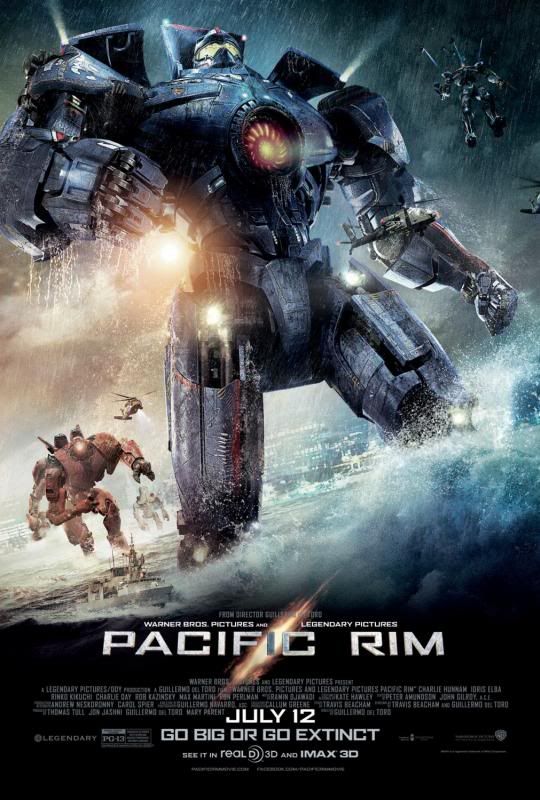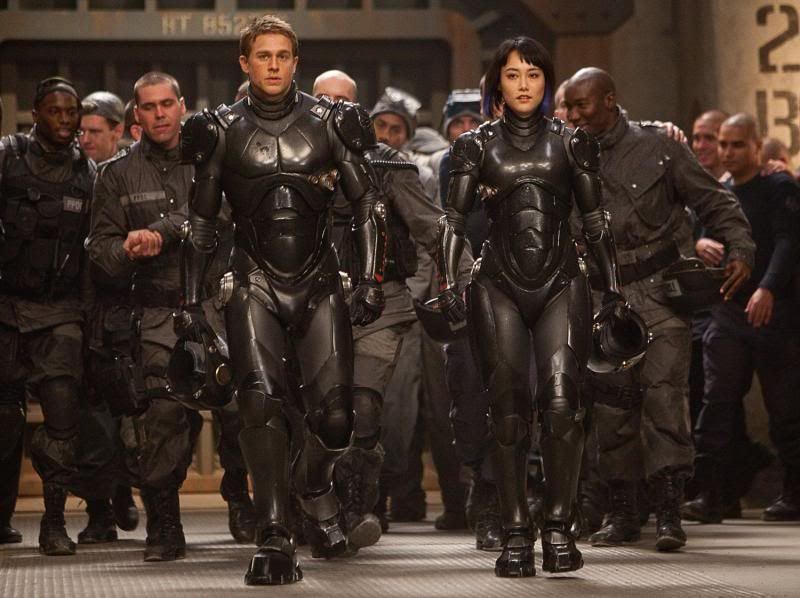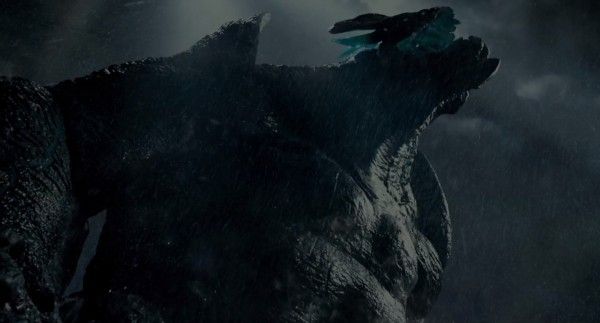Moving pictures are first and foremost a form of entertainment. As much as the storytelling form has evolved to deliver stunning achievements such as 2001: A Space Odyssey and introverted art-haus “tour-de-force” experiences like Antichrist, not every film has to reach for those existentialist or high-minded goals. Sometimes, a writer or director wants to tell a straightforward story. They want to pay homage to the films that made them interested in the medium in the first place. They want to use the tools they’ve learned to wield to craft something previously considered impossible. One such director is Guillermo del Toro, and one such movie is Pacific Rim.

Sometime within the next year at the time of writing this, a major geological event will happen in the depths of the Pacific Ocean. Two tectonic plates will pull apart and reveal a rift between our world and another dimension. Out of that rift come massive, city-destroying monsters, which we come to call kaiju. Conventional weaponry is barely effective and dangerous to use, so humanity bands together to create Jaegers, human-piloted robots comparable in size to the kaiju and capable of throwing down with them. While they prove capable of handling the kaiju, many world leaders feel more confident in massive safety walls to hide behind, and so the Jaeger program is discontinued. Unwilling to go down without a fight, the remaining Rangers and their Jaegers rally for a last-ditch assault on the rift itself.
Destruction on a massive scale is a staple of blockbuster movies. Even this year, cities and buildings and skyscrapers alike have been leveled. What sets Pacific Rim apart, other than its unique premise unfettered by extant intellectual property, is that it is shot and presented in a way that gives the audience a true sense of scale in terms of the battles and the disaster. Everything is cleanly shot, and the kaiju in particular have unique looks, abilities, and even personalities that come across in their design and movement. It is a testament to del Toro’s eye and imagination that these monsters, which could have been generic and interchangeable, have a sense of uniqueness without a word needing to be spoken. And considering how much time is devoted to them, that goes triple for the Jaegers.

There’s nothing wrong with keeping your story & characters simple.
In addition to the fact that they’re giant warrior robots that are definitely an homage to everything from the many Gundam suits to Big O, the Jaegers are the vehicles by which are heroes are destined to ride to victory. What sets them apart is the fact that running a war machine that massive with a neural interface is too taxing for a single human brain. As the pilot is essentially the brain of the machine, two pilots, one for each hemisphere of the brain, should be linked together to operate a Jaeger. Not only does this make the realization of the Jaegers another unique aspect of Pacific Rim, it allows characters to come into their own without wordy exposition. While there will be moments that are certain to cause frothing rage amongst physics experts, none of the admittedly questionable science is explained away with overly wordy technobabble. Both of these facts are marks in the favor of the film.
Going back to the characters, the mechanics of the “Drift” (the connection the pilots share) allow our main characters to become three-dimensional and realized through action and visuals rather than more traditional back-and-forth dialog. Mako Mori, in particular, gains her depth and motivation from what we see of her when she enters the Drift for the first time. Raleigh Becket, who until this point was a somewhat typical if well-implemented action movie protagonist, shifts to our point of reference character, and shows us the hidden depths of the characters while continuing to deliver on scale and powerful visual style. The characters in Pacific Rim may not be the most complex you’ll ever encounter in cinema, but what is done with them is done very well, showing instead of telling at almost every turn. At no point are we thrown out of the experience because Idris Elba or Ron Perlman have to turn to the camera and explain something to audience. Performances are immediate, immersive, and another well-polished facet of this absolute gem.

It’s good to see movie monsters this unique, diverse, and menacing.
When you get right down to it, Pacific Rim is a simple movie. Big monsters, big robots, they fight, restart the clock. But its simplicity is actually a strength. Without the expectations of a franchise, anticipation of a sequel or prequel, and freedom from existential angst or greater metaphors, the story can be told at a good pace with visual panache and a deep and abiding love for all of the inspiration that’s lead us to this moment. I would like to reiterate something I’ve said in the past, however: simple is not the same thing as dumb. The story is not interested in any cinematic or narrative slight-of-hand to convince you that it’s anything more than the apex of monster movies, the spiritual descendant of everything from Godzilla to the Power Rangers all grown up and going about its business of thrilling action set pieces and swaths of wanton destruction with brains, style, and precision. Simple as it is, Pacific Rim is also very smart as well as being downright joyous and boisterous in its presentation, which is a very nice change of pace from most of the stuff we get from Hollywood these days.
Stuff I Liked: This world feels real in a lot of ways. I like that people react to both the kaiju and the Jaegers in realistic ways – some love them both and just like seeing them fight, some fear the Jaegers just as much as the kaiju, some are just in it to make money, etc. A lot of little touches stand out to me: Gypsy Danger’s ‘nose art’, the use of the Hansen’s dog on their jackets, Pentecost’s name stenciled onto his tin, the way each kaiju appears to be inspired by a different sea creature, etc.
Stuff I Didn’t Like: The quirky scientists were perhaps a bit too quirky. The simplicity of the plot leads it to be somewhat predictable, even if the presentation is good and smart. We barely get a feel for the Rangers who are not our heroes.
Stuff I Loved: The action set pieces rightfully take center stage, because they are truly awesome in scope and implementation. There are genuine thrills to be had from beginning to end. Idris Elba and Ron Perlman are two of my favorite actors, and I’m glad that they’re the biggest names in the cast. The movie does not feel its length, does not overstay its welcome, does what it does with panache and flair, and is certain to stand up to repeated viewings.
Bottom Line: Pacific Rim is pure, undiluted, unashamed, and utterly enjoyable cinematic entertainment. It doesn’t bring you down with dour plodding and stone-faced seriousness like Man of Steel. It may crib notes from everything from Godzilla movies to Neon Genesis Evangelion, but it does not retread ideas wholesale like Star Trek: Into Darkness. Masterful direction, decent characterization, a fully-realized and original world that feels both lived-in and inclusive, surprisingly realistic proportions and physics, and an overall sense of fun and excitement elevates it above the mediocrity of other summer movies. While it may never win any awards for gripping interpersonal drama or mind-bending existential angst, it should win one for existing at all in this cynical, materialistic, overly smug and downright depressing age. It’s fun at the movies the way fun at the movies should be. If you can get behind the idea that it’s okay for a movie to be fun, you’ll enjoy Pacific Rim quite a bit; if, on the other hand, you think “movies” and “fun” are not something that should cohabit, I guess you’ll have to wait until Nietzsche’s Ecco Homo gets adapted into a film before going to the cinema again.



Leave a Reply